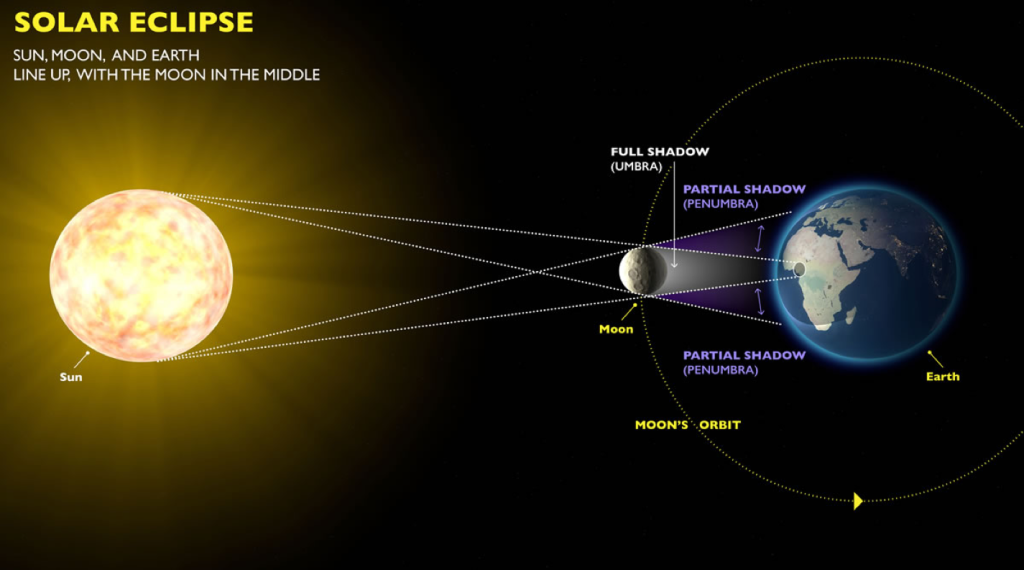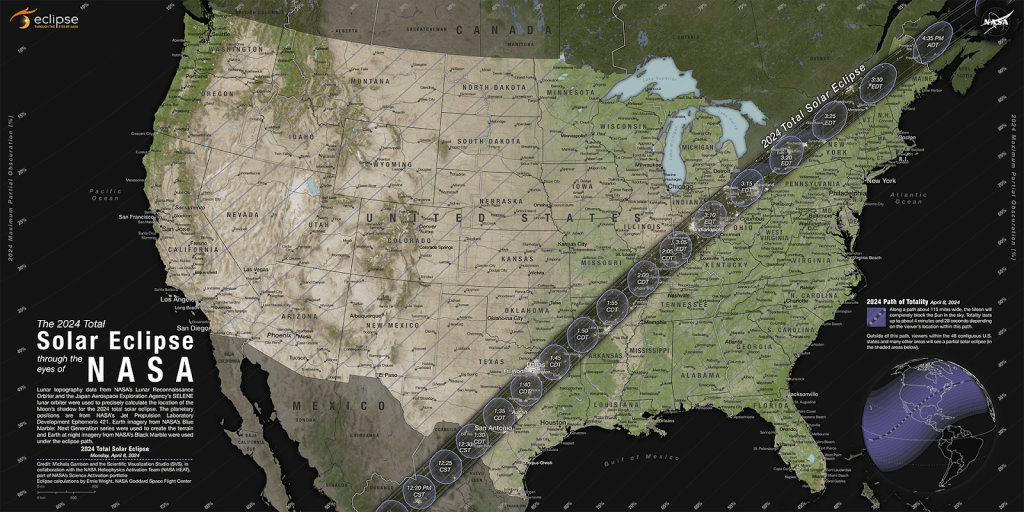Subscribe to our WhatsApp Channel
On average, a total solar eclipse can occur once every 18 months somewhere on Earth, yet the chances of a particular location getting to witness multiple total solar eclipses in one’s lifetime are quite rare. Millions of people in North America will witness a total solar eclipse on 8th April 2024.
As with any major celestial event, social media is abuzz with this rare phenomenon, and many conspiracy theories have emerged related to the April 8th eclipse. Many of these claims revolve around themes such as how this solar eclipse would affect sectors such as agriculture, climate change, disaster, and weather.
As the buzz around the April 8th eclipse and the related conspiracy theories grows, we are committed to providing you with a scientific perspective. Our aim is to delve into the fundamental scientific background and potential impact of the solar eclipse. Let’s start by understanding the science behind a solar eclipse.
Solar Eclipse –
A solar eclipse is a fascinating event that occurs when the moon aligns perfectly between the Earth and the sun, blocking all or part of the sun’s light. This alignment only happens during the new moon phase, when the sun, moon, and the Earth are in a straight line.

The scientific background of a solar eclipse involves understanding the mechanisms of celestial bodies’ orbits and the interaction between the sun, moon and earth.
- Orbital mechanism – The Earth orbits around the sun, and the moon orbits around the Earth. The moon’s orbit is inclined relative to the Earth’s orbit around the sun. Most of the time, the moon’s orbit takes it either above or below the line connecting the Earth and the sun, so it doesn’t block the sun’s light. However, during a solar eclipse, the moon’s orbit intersects with the earth’s orbit, causing it to come between the Earth and the sun.
- New moon phase – A solar eclipse occurs during the new moon phase when the moon is positioned between the earth and the sun. During this time, the side of the moon facing the Earth is not illuminated by sunlight, making it appear invisible in the sky to observe on Earth.
- Alignment—For a solar eclipse to occur, the sun, moon, and earth must be in nearly perfect alignment, with the moon positioned directly between them. This alignment allows the moon to cast its shadow on the planet, blocking the whole or part of the sun.
- Types of solar eclipse—There are different types of solar eclipses based on the relative positions of the sun, moon, and the Earth.
- Total solar eclipse: When the moon completely covers the sun’s disk, casting a shadow on the earth and creating a temporary darkness in the path of totality.
- Partial solar eclipse: Only a portion of the sun is obscured by the moon, resulting in a partial shadow on the Earth.
- Annular solar eclipse: When the moon is too far from Earth to completely cover the sun, leaving a ring of sunlight visible around the edges of the moon’s silhouette.

- Path of totality—During a total solar eclipse, there is a narrow path on the Earth’s surface where observers can witness the eclipse’s total phase. This path varies for each eclipse and depends on the alignment of the sun, moon, and earth.
April 8th Total Solar Eclipse 2024
The upcoming total solar eclipse will take place on 8th April 2024 and be visible across parts of North America. Here is the data that NASA provided on this solar eclipse.

The total duration of this solar eclipse will be up to 4 minutes and 27 seconds. Senior Research Scientist Dr Indika Medagangoda from Arthur C. Clarke Institute for Modern Technologies confirmed that this is not visible to Sri Lanka, even as a partial eclipse. Here are the full details of the visible solar eclipse in Asia in the near future.
Also Read: You CANNOT See the April 8th Solar Eclipse from Sri Lanka! Don’t Be Eclipsed by Misinformation!
Environmental Changes in the Period of Total Solar Eclipse –
When the moon completely blocks the sun’s rays, evidently, the area where the eclipse is visible will become darker. Significantly, the zone that can see the total eclipse will become darker than other areas as if it were nighttime. Along with blocking sunlight, the environment will also get colder than usual during the day. But this environmental change will only last a few minutes during the eclipse.
However, this is a sudden change in the environment, and animals and plants, which are more sensitive to environmental changes than humans, are reacting to these changes. During the total solar eclipse on 29 March 2006, some scientists used various techniques to measure the impacts. According to these researchers, the field crops decreased their photosynthesis rate during this time, and zooplankton showed their nighttime behaviour.
In another research on animal behaviour from studying the animals in Riverbank Zoo in Columbia, South Carolina, during the 2017 total solar eclipse, scientists observed that 75% of the animals from the zoo started to show their nighttime behaviour during the duration of the total solar eclipse. Many animals in the zoo showed confusion and anxiety. Another research on the bees’ behaviour found that bees completely stopped flying for foraging during the totality of the total solar eclipse. But they seemed unaffected during the partial totality.
Total Solar Eclipse Impact on Agriculture
Research on the total solar eclipse’s impact on field crops in 2006 found a dramatic drop in the photosynthetic rate in plants such as cereal and leguminous crops. However, this drop in photosynthetic rate varies for different species of crops. Photosynthesis is the most important mechanism of a plant. This mechanism controls many plant processes. However, the research shows that increased photosynthesis metabolism is essential for improving crop yield.
However, a plant’s photosynthesis rate drop will only occur for a few minutes, so it cannot significantly affect crop yields. Also, scientists worldwide do not expect a negative impact from a solar eclipse on crops in the area. They hope that livestock will be more affected by this event than crop yields.
However, Tim Reinbott, the Director of Field Operations at the University of Missouri’s South Farm Research Center, is eagerly waiting to do research on the reactions of drought-stressed soybean plants during the eclipse. Biology Professor Candi Galen in Missouri will also track the behavioural changes of chickens and cattle during this time. Here‘s more on that.
Total Solar Eclipse Impact on Weather –
- Temperature: Many affected areas will experience a significant temperature drop. In some places, it is predicted to be around 10°C. However, this situation only lasts a few minutes when the solar eclipse occurs. At the end of the phenomenon, the temperature will normalize again within a few minutes. In the 2017 total solar eclipse in the USA, the areas with lower humidity showed noticeable fluctuations in temperature.
- Wind: This sudden cooling effect caused by the eclipse can lead to shifts in the wind patterns as the atmosphere adjusts to the changing temperature. Scientists at the United Kingdom’s University of Reading have researched and proved that the wind speed drops and changes in the direction of the wind are connected to the total solar eclipse. Professor Giles Harrison from the University of Reading explained this incident further. According to Prof. Giles, warm air stopped rising from the ground when the earth’s surface suddenly cooled down. This slows down the air speed on the Earth, decreasing wind speed and affecting the wind’s direction.
- Cloud: The cooling effect of the eclipse may influence cloud formation and dissipation patterns, potentially leading to changes in cloud cover during the event.
- Atmospheric pressure: The temporary changes in temperature and wind patterns during a solar eclipse can also cause fluctuations in atmospheric pressure.
Here to read more on the total solar eclipse’s impact on weather.
Do Total Solar Eclipse Trigger Storms? –
Storms include strong winds, precipitation, thunder, lightning, hail, or even tornadoes. As Professor Giles Harrison explained, the solar eclipse may be able to decrease the wind speed and change the direction of the wind. But these facts are not trigger points for the storms. Precipitation, thunder, and lightning are not connected to solar eclipse. So, a total solar eclipse cannot be considered a reason to trigger storms.
According to Professor Ingo Mueller-Wodarg of Imperial College London, the effect of the solar eclipse on the troposphere or weather layer of the atmosphere is less affected by a solar eclipse.
“You can argue that the moving shadow causes a local cooling, by a few degrees, the launch of atmospheric gravity waves and a degree of atmospheric turbulence.” He adds, “Given the right circumstances, these could contribute towards a local thunderstorm, but since the effect of the eclipse is very small in the lower atmosphere, you would be lucky to find this; there is certainly not a direct causal relationship that every eclipse causes thunderstorm and lightning.”
However, it is possible to develop stormy conditions when a total solar eclipse occurs. However, according to current research and data, storms are a totally independent phenomenon from solar eclipses. Click here to read more on this.
Do Total Solar Eclipse Trigger Earthquakes? –
Earthquakes are primarily caused by the movement of tectonic plates beneath the Earth’s surface, which releases stored energy in the form of seismic waves. These movements occur due to geological processes such as plate tectonics, volcanic activities, or human-induced activities like mining or reservoir-induced seismicity.
While it is true the gravitational forces exerted by the sun and moon can influence the Earth’s tides and potentially stress the Earth’s crust slightly, the effect of a solar eclipse in gravitational variations is not significant enough to trigger earthquakes, which are typically caused by much larger and more complex geological processes operating over longer time scales.
Therefore, while there may be some tiny and localised variations in gravitational forces during a solar eclipse, they are not capable of directly causing earthquakes.
However, it is estimated that 55 earthquakes a day are detected daily around the world, according to the National Earthquake Information Center. There are 20,000 earthquakes annually. Few of them are strong enough to cause a huge disaster. Even in a special phenomenon such as a total solar eclipse, there is a possibility of an earthquake happening. But there is no connection between those two phenomena. It can be a co-incident. Here to read more on this.
Follow us and stay up to date with our latest fact checks.
Facebook | Twitter | Instagram | Google News | TikTok

Title:Do Total Solar Eclipses Trigger Earthquakes and Storms? Find out the facts…
Fact Check By: Fact Crescendo TeamResult: Insight






